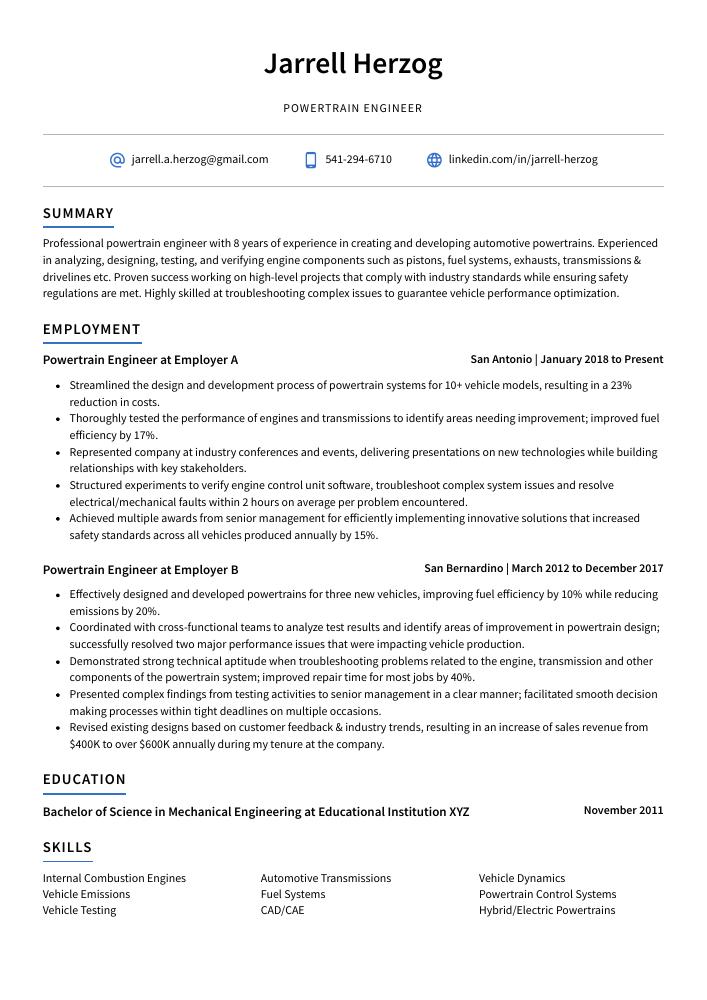Powertrain Engineer Resume Guide
Powertrain Engineers are responsible for the design and development of powertrains, which consist of components such as engines, transmissions, and drive systems. They analyze performance data from prototype testing to ensure that the system meets required specifications and work closely with other engineering teams to integrate their designs into existing vehicle platforms.
Your expertise in powertrain engineering is second to none, and you could be a great asset to any automotive company. But they don’t know who you are yet. To make yourself stand out from the crowd, you must create a resume that showcases your skillset and experience.
This guide will walk you through the entire process of creating a top-notch resume. We first show you a complete example and then break down what each resume section should look like.
Table of Contents
The guide is divided into sections for your convenience. You can read it from beginning to end or use the table of contents below to jump to a specific part.
Powertrain Engineer Resume Sample
Jarrell Herzog
Powertrain Engineer
[email protected]
541-294-6710
linkedin.com/in/jarrell-herzog
Summary
Professional powertrain engineer with 8 years of experience in creating and developing automotive powertrains. Experienced in analyzing, designing, testing, and verifying engine components such as pistons, fuel systems, exhausts, transmissions & drivelines, etc. Proven success working on high-level projects that comply with industry standards while ensuring safety regulations are met. Highly skilled at troubleshooting complex issues to guarantee vehicle performance optimization.
Experience
Powertrain Engineer, Employer A
San Antonio, Jan 2018 – Present
- Streamlined the design and development process of powertrain systems for 10+ vehicle models, resulting in a 23% reduction in costs.
- Thoroughly tested the performance of engines and transmissions to identify areas needing improvement; improved fuel efficiency by 17%.
- Represented company at industry conferences and events, delivering presentations on new technologies while building relationships with key stakeholders.
- Structured experiments to verify engine control unit software, troubleshoot complex system issues, and resolve electrical/mechanical faults within 2 hours on average per problem encountered.
- Achieved multiple awards from senior management for efficiently implementing innovative solutions that increased safety standards across all vehicles produced annually by 15%.
Powertrain Engineer, Employer B
San Bernardino, Mar 2012 – Dec 2017
- Effectively designed and developed powertrains for three new vehicles, improving fuel efficiency by 10% while reducing emissions by 20%.
- Coordinated with cross-functional teams to analyze test results and identify areas of improvement in powertrain design; successfully resolved two major performance issues that were impacting vehicle production.
- Demonstrated strong technical aptitude when troubleshooting problems related to the engine, transmission, and other components of the powertrain system; improved repair time for most jobs by 40%.
- Presented complex findings from testing activities to senior management in a clear manner; facilitated smooth decision-making processes within tight deadlines on multiple occasions.
- Revised existing designs based on customer feedback & industry trends, increasing sales revenue from $400K to over $600K annually during my tenure at the company.
Skills
- Internal Combustion Engines
- Automotive Transmissions
- Vehicle Dynamics
- Vehicle Emissions
- Fuel Systems
- Powertrain Control Systems
- Vehicle Testing
- CAD/CAE
- Hybrid/Electric Powertrains
Education
Bachelor of Science in Mechanical Engineering
Educational Institution XYZ
Nov 2011
Certifications
Certified Automotive Powertrain Engineer
Society of Automotive Engineers
May 2017
1. Summary / Objective
A resume summary for a powertrain engineer should be concise yet informative. It should highlight your technical expertise and experience in the field, as well as any special certifications or awards you have earned. For example, you could mention that you are an expert in engine design and development, possess advanced knowledge of fuel systems and emissions control technologies, have a Masters’s degree in Automotive Engineering from XYZ University, and won the ABC Award for Powertrain Innovation last year.
Below are some resume summary examples:
Driven Powertrain Engineer with a proven track record of designing and developing innovative powertrains for the automotive industry. Expertise in validating, testing, and modifying new/existing designs to meet customer requirements on time and within budget. At XYZ Corporation, developed advanced fuel-saving engines that reduced emissions by up to 20%. Awarded 2nd place at ABC Innovation Contest for creative problem-solving skills during engine design process.
Enthusiastic powertrain engineer with 5+ years of experience in designing, developing, and testing high-performance powertrains for a variety of applications. Proven ability to manage complex projects from concept through completion. Adept at utilizing computer software programs to design engines, transmissions, clutches, and other components. Looking to join ABC Company as a Powertrain Engineer and help drive the next generation of vehicle innovation.
Dependable Powertrain Engineer with 7+ years of experience designing and testing powertrains for both passenger and commercial vehicles. At XYZ, led the development team in creating a new line of fuel-efficient engines that improved emissions by 20%. Skilled at optimizing engine performance using 3D modeling software, CAD tools, and combustion analysis. Highly motivated to deliver high-quality results on time and within budget constraints.
Energetic and driven Powertrain Engineer with 5+ years of experience in the automotive industry. Adept at developing, testing, and troubleshooting powertrains to meet customer needs. Proven track record for delivering innovative solutions that improve performance, reduce emissions and maximize fuel economy. At XYZ Automotive Inc., saved 10% on average costs per prototype by streamlining processes and introducing new technologies.
Determined powertrain engineer with 5+ years of experience in the automotive industry, including developing designs and testing for fuel efficiency, power output, safety features, and reliability. Seeking to join ABC Motors as a Powertrain Engineer to develop innovative solutions that allow vehicles to meet customer needs while optimizing performance. Proven track record of successful projects resulting in up to 8% cost savings.
Hard-working powertrain engineer with 5+ years of experience designing, developing and testing gasoline-powered engines. Adept in both traditional and modern techniques to enhance performance while meeting emission standards. Seeking to join ABC Motors as a powertrain design engineer where I can use my knowledge and skills to contribute towards the development of fuel-efficient vehicles.
Diligent powertrain engineer with 7+ years of experience in designing, developing, and testing mechanical systems for vehicles. At ABC Motors, designed over 50 powertrain components from concept to production. Received the “Innovation Award” for a new gearbox design that increased fuel efficiency by 10%. Expertise in CAD/CAE tools such as CATIA V5 and MATLAB Simulink.
Proficient powertrain engineer with 5+ years of experience designing and verifying powertrains for automotive vehicles. Seeking to join ABC Tech to use my expertise in CAD/CAM software, such as SOLIDWORKS, CATIA V5, and Creo Parametric. At XYZ Company, I increased vehicle efficiency by 8% through innovative design strategies.
2. Experience / Employment
Next comes the work history section, where you provide details on your employment history. This should be written in reverse chronological order, so list your most recent role first.
When talking about what you did, stick to bullet points for the sake of clarity and brevity. Take some time to think about the specifics of what you did and any results that were achieved as a result of your work.
For example, instead of saying “Improved engine performance,” you could say, “Developed an advanced fuel injection system which increased power output by 10% while reducing emissions by 20%, resulting in improved overall engine efficiency.”
To write effective bullet points, begin with a strong verb or adverb. Industry-specific verbs to use are:
- Designed
- Analyzed
- Optimized
- Fabricated
- Assembled
- Programmed
- Calibrated
- Troubleshot
- Tested
- Inspected
- Validated
- Documented
- Implemented
- Monitored
- Researched
Other general verbs you can use are:
- Achieved
- Advised
- Assessed
- Compiled
- Coordinated
- Demonstrated
- Developed
- Expedited
- Facilitated
- Formulated
- Improved
- Introduced
- Mentored
- Participated
- Prepared
- Presented
- Reduced
- Reorganized
- Represented
- Revised
- Spearheaded
- Streamlined
- Structured
- Utilized
Below are some example bullet points:
- Proficiently designed, developed, and tested powertrain systems for 5+ projects; reduced product development timeline by 25% through improved design processes.
- Reduced production costs of vehicle components by 15% while meeting all safety standards & environmental regulations in the process.
- Mentored three junior engineers on advanced automotive engineering principles, providing guidance throughout each project’s testing and validation phases.
- Spearheaded a new initiative to test 10+ powertrains with optimized parts; successfully negotiated contracts with vendors to reduce supply chain expenses by $250,000 annually.
- Prepared detailed reports documenting results from various tests conducted on transmission systems and other mechanical components; identified areas for improvement that resulted in increased fuel efficiency across vehicles by 7%.
- Advised on design specifications and prototyping of powertrain systems for 5+ new vehicle models, resulting in a 20% improvement in fuel efficiency.
- Programmed complex algorithms to simulate powertrain performance across different driving conditions; identified 10+ optimization opportunities that led to improved engine output and torque stability.
- Monitored test runs on over 50+ gasoline engines, diesel engines, and hybrid-electric vehicles; lowered emissions by 15%.
- Meticulously conducted detailed root cause analysis into recurring problems with powertrains such as transmission failure or stalling; reduced mean time to repair (MTTR) from 3 hours/case to 2 hours/case on average.
- Participated actively in the development process by providing feedback and suggestions regarding component selection, optimization strategies & testing protocols; successfully launched 7 production-ready designs within budgeted timelines & resources allocated.
- Calibrated and tested over 10 new powertrain systems, reducing system issues by 25%.
- Assembled and installed 50+ components in vehicles to optimize performance of the vehicle’s engine, transmission, suspension, and brakes; improved fuel efficiency by 15% on average.
- Introduced a cost-effective solution for modeling dynamic behavior of powertrains that increased production output by 20%.
- Confidently led a team of 5 engineers through the development process from concept design to prototype validation; saved $15K in material costs due to efficient workflow management techniques employed during project duration.
- Implemented quality assurance measures across all stages of product engineering and testing for optimal product performance with minimal errors or defects; reduced defect rate by 12%.
- Developed and tested over 20 powertrain systems, substantially reducing engine noise and vibration by 35%.
- Utilized analytical methods to evaluate thermal characteristics of the powertrains and modify them accordingly; improved fuel efficiency by 15% across all vehicles.
- Formulated advanced models for simulating vehicle response under different driving conditions; optimized system performance by 10%.
- Substantially increased production rate through efficient troubleshooting techniques, saving an average of $5,000 per month in labor costs.
- Facilitated on-site installations with automotive manufacturers and conducted quality inspections post installation; completed projects within budgeted time frames +20 times in a row without any defects reported afterwards.
- Diligently designed, tested, and validated powertrain systems for 27+ vehicles in the last 18 months; improved fuel efficiency by 8% on average.
- Reorganized production lines to reduce gearbox assembly time from 10 to 5 hours, resulting in $2,300 cost savings per vehicle manufactured.
- Documented all test results and created detailed reports outlining specifications & performance metrics of various components used in the powertrains; delivered comprehensive documentation packages to automotive customers within tight deadlines.
- Troubleshot a variety of mechanical issues related to engines, transmissions, and brake systems using diagnostic equipment; successfully identified root cause problems for 70+ vehicles with an accuracy rate of 90%.
- Researched new technologies such as electric motors & transmission control units (TCUs) that could be implemented into existing designs, leading to increased customer satisfaction ratings by 22%.
- Inspected and tested 30+ powertrain components, including engines and transmissions, to ensure compliance with OEM specifications while reducing the production time by 17%.
- Validated design changes on multiple engine models using advanced computer simulation tools; identified potential issues and offered solutions that improved product performance by 7%.
- Consistently monitored fuel efficiency improvements through rigorous testing to meet EPA standards; achieved a 20% reduction in emissions over 3 years.
- Optimized existing designs of powertrains based on customer feedback which increased consumer satisfaction ratings by 14 points within 12 months.
- Designed innovative prototype parts for 5 new vehicle applications using CAD software which reduced development costs by $20K each year since implementation.
- Tested and validated powertrain systems across 15+ vehicle models, achieving a 28% decrease in emissions and a 25% increase in fuel economy.
- Analyzed data from bench tests of exhaust systems, transmissions, and engines to identify opportunities for performance improvements; implemented modifications that produced an average gain of 7 horsepower per engine model.
- Expedited the troubleshooting process by creating comprehensive diagnostic reports with detailed technical specifications based on test results; reduced time-to-repair cycles by 45%.
- Successfully developed a fast-acting system response algorithm to reduce vibrations caused by shifting gears during high-speed acceleration – improved driving comfort ratings among customers by 20%.
- Compiled over 100 engineering design documents detailing all aspects of each powertrain assembly line procedure, including quality control standards and safety protocols; this allowed production teams to meet production targets within budget constraints every month consistently for 2 years straight without fail or incident.
- Assessed and tested powertrain components for performance, durability, and reliability; identified potential areas of improvement in the designs and implemented changes to reduce development time by 10%.
- Actively collaborated with cross-functional teams, including design engineers, suppliers & customers, on various projects related to powertrain engineering; successfully launched three new products within budgeted timeline constraints.
- Improved existing engine system operations through innovative methods such as lean manufacturing techniques, which resulted in cost savings of $500K annually while enhancing overall production efficiency by 15%.
3. Skills
Skill requirements will differ from one employer to the next; this can easily be ascertained from the job posting. Organization A may be looking for a powertrain engineer with experience in combustion engines, while Organization B may seek someone knowledgeable about electric vehicles.
It is essential to tailor your resume’s skills section to each job you are applying for because many employers use applicant tracking systems these days. Their role is to scan resumes for certain keywords before passing them on to a human.
It’s important not just to list the skills here but also to elaborate in the summary and work history sections on how they have been applied in past professional experiences or projects.
Below is a list of common skills & terms:
- Automotive Transmissions
- CAD/CAE
- Fuel Systems
- Hybrid/Electric Powertrains
- Internal Combustion Engines
- Noise, Vibration, and Harshness (NVH) Analysis
- Powertrain Control Systems
- Vehicle Dynamics
- Vehicle Emissions
- Vehicle Testing
4. Education
Mentioning an education section on your resume will depend on how far along you are in your career. If you just graduated and have no prior experience, include this information below your resume objective. However, if you have been working as a powertrain engineer for years with plenty of different responsibilities to showcase, omitting the education section is perfectly acceptable.
If an education section is included, highlight courses and subjects related to powertrain engineering that may help demonstrate knowledge of the job requirements.
Bachelor of Science in Mechanical Engineering
Educational Institution XYZ
Nov 2011
5. Certifications
Certifications are a great way to show potential employers that you have the necessary skills and knowledge for a certain role. They also demonstrate your commitment to professional development, as well as your ability to stay up-to-date with industry trends.
Including certifications in your resume can be beneficial if they are relevant to the position you are applying for or if they showcase specialized skills that could give you an edge over other applicants.
Certified Automotive Powertrain Engineer
Society of Automotive Engineers
May 2017
6. Contact Info
Your name should be the first thing a reader sees when viewing your resume, so ensure its positioning is prominent. Your phone number should be written in the most commonly used format in your country/city/state, and your email address should be professional.
You can also choose to include a link to your LinkedIn profile, personal website, or other online platforms relevant to your industry.
Finally, name your resume file appropriately to help hiring managers; for Jarrell Herzog, this would be Jarrell-Herzog-resume.pdf or Jarrell-Herzog-resume.docx.
7. Cover Letter
Including a cover letter when applying for a job is an important step in the recruitment process. It should be 2 to 4 paragraphs long and provide more detail on who you are and why you’re suited for the role.
Cover letters help demonstrate your suitability as a candidate beyond what’s mentioned in your resume, making it easier for recruiters to get to know you better. They also show that extra effort has been taken which can give you an edge over other applicants.
Below is an example cover letter:
Dear Sandra,
I am writing in response to your posting for a Powertrain Engineer. With over 10 years of experience designing, developing, and testing powertrains for the automotive industry, I am confident I will be an asset to your team.
My experience includes working with internal combustion engines, electric motors, and battery systems. I have also led teams of engineers in the design and development of powertrain systems. In my most recent position, I was responsible for managing the powertrain engineering department at [company name]. In this role, I oversaw a team of 15 engineers and technicians responsible for developing new powertrain technologies.
I have a Bachelor’s degree in Mechanical Engineering from [university name] and a Master’s degree in Automotive Engineering from [university name]. My education combined with my hands-on experience has given me the skills and knowledge necessary to be successful in this role.
I am excited about the opportunity to join your organization and contribute to your success. Please find attached a copy of my resume detailing my experience and qualifications. I can be reached anytime via phone or email should you have any questions or would like to schedule an interview at your earliest convenience. Thank you for your time and consideration; I look forward to hearing from you soon!
Sincerely,
Jarrell
Powertrain Engineer Resume Templates
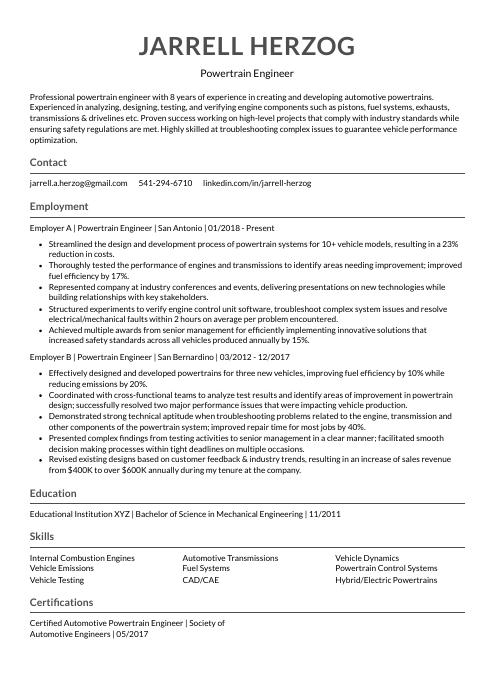 Indri
Indri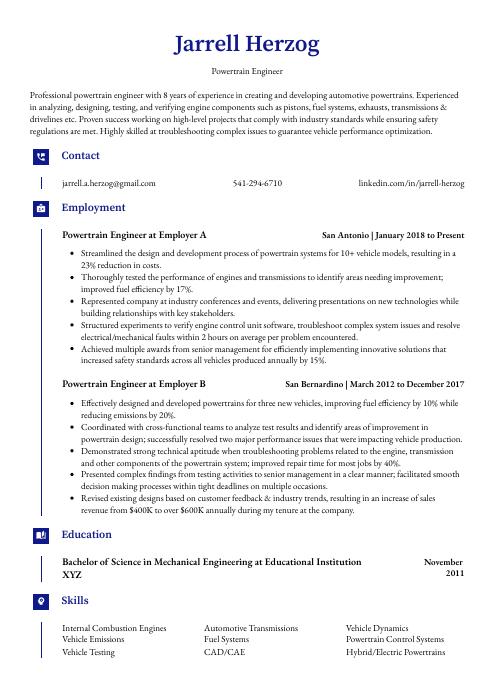 Gharial
Gharial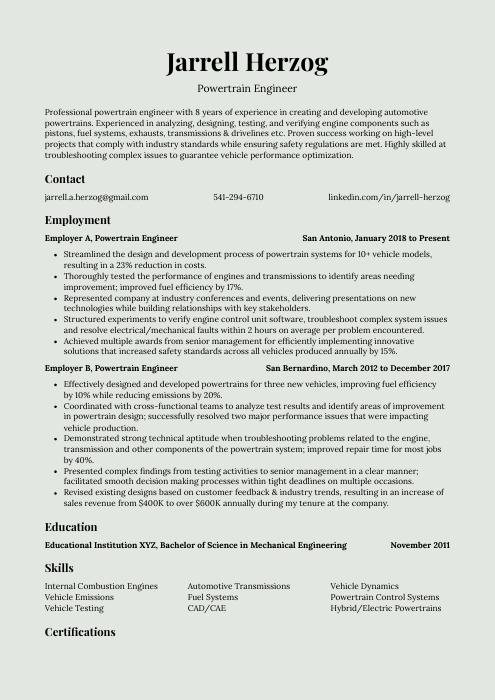 Saola
Saola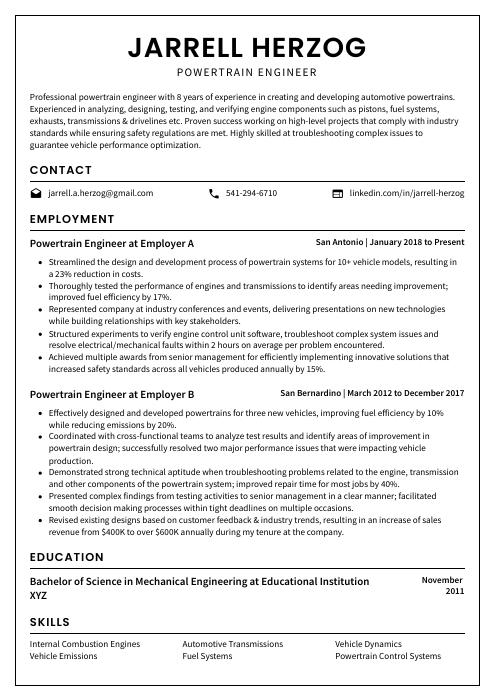 Cormorant
Cormorant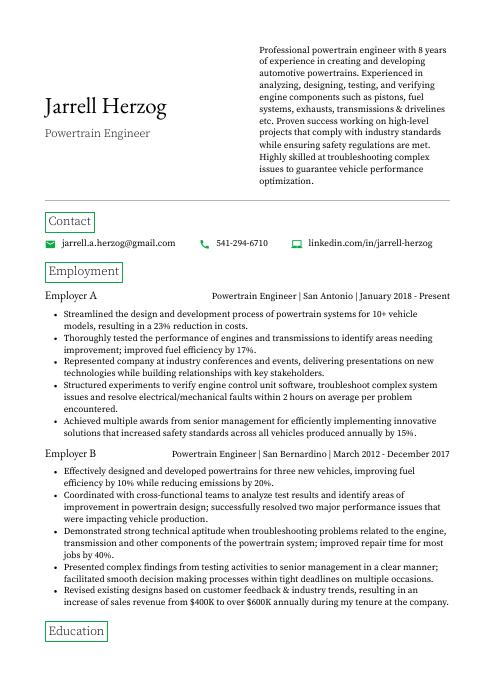 Quokka
Quokka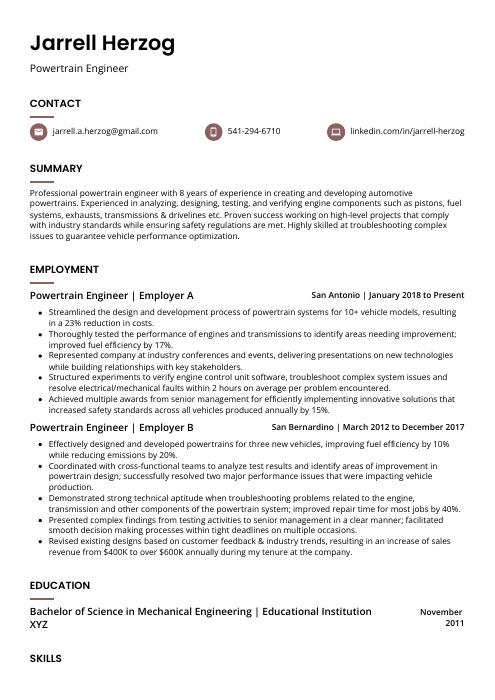 Fossa
Fossa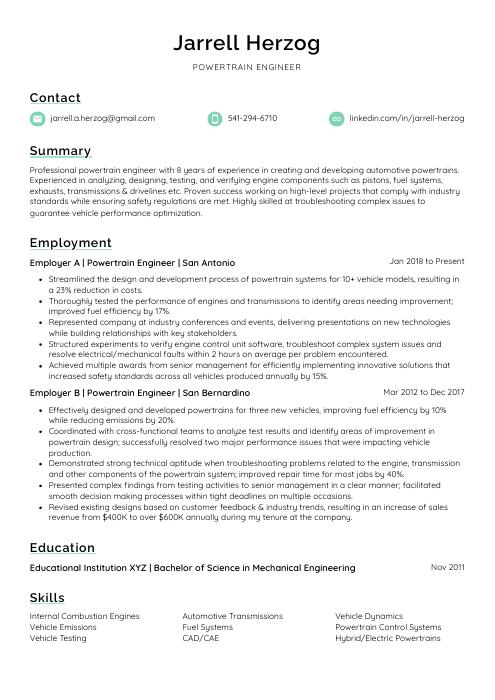 Lorikeet
Lorikeet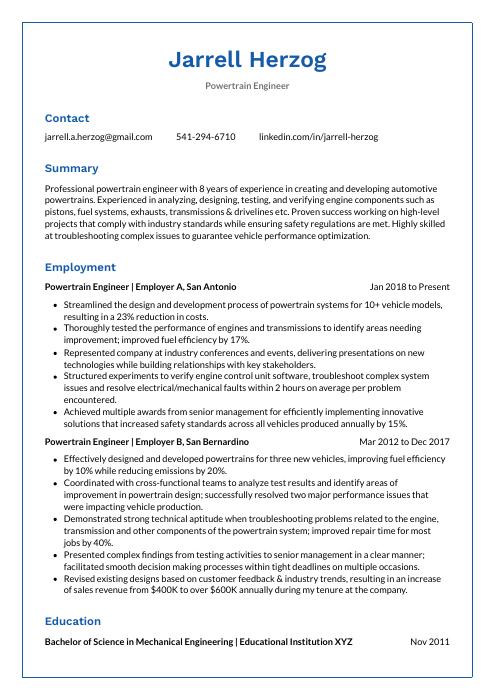 Markhor
Markhor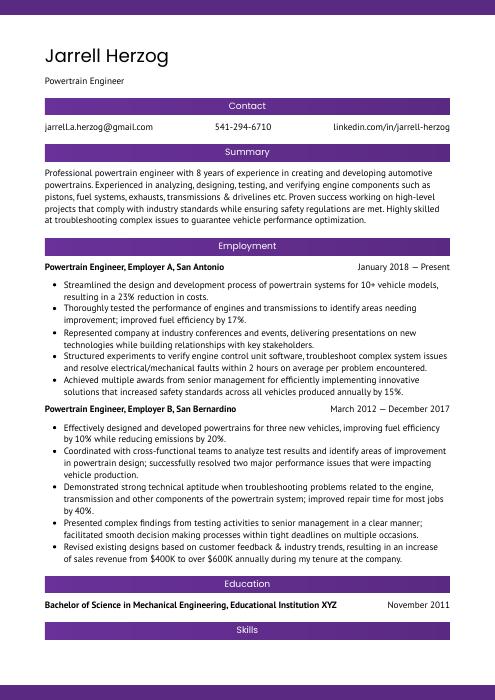 Jerboa
Jerboa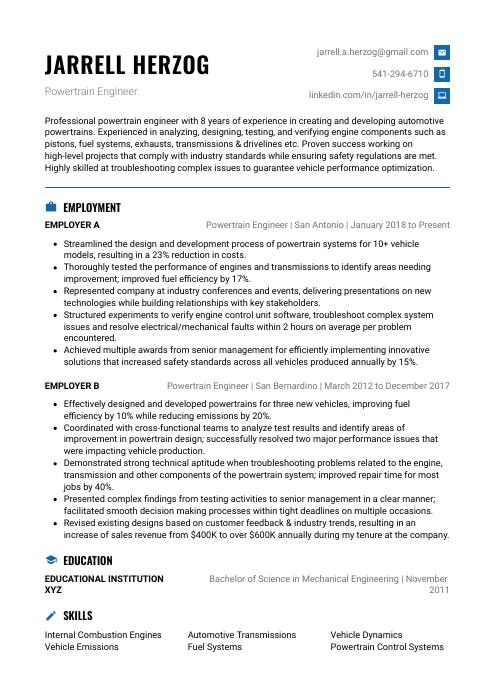 Echidna
Echidna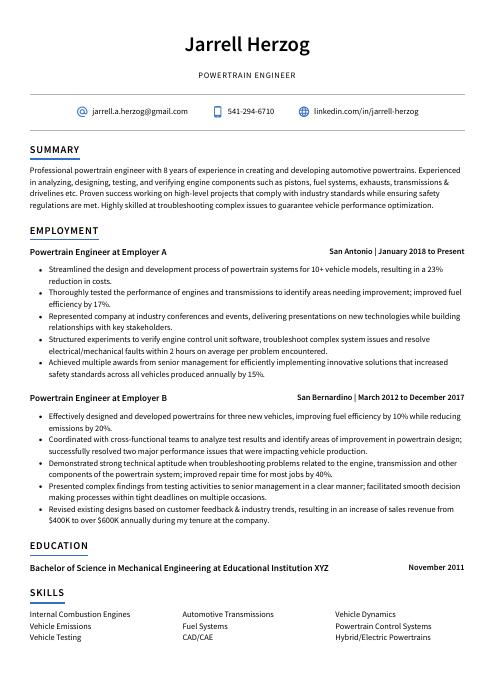 Axolotl
Axolotl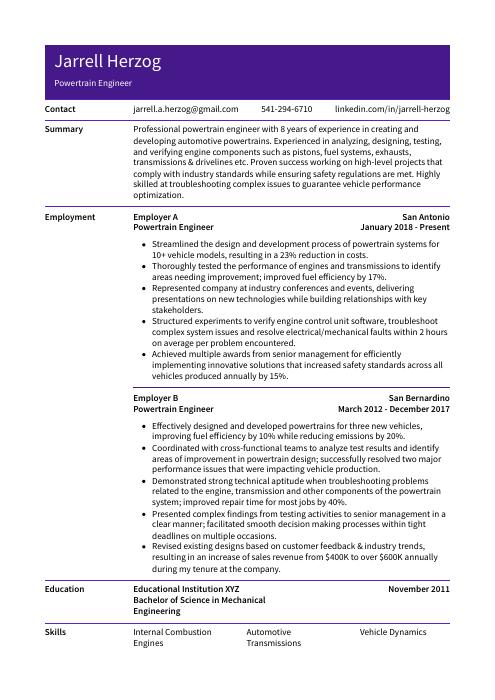 Pika
Pika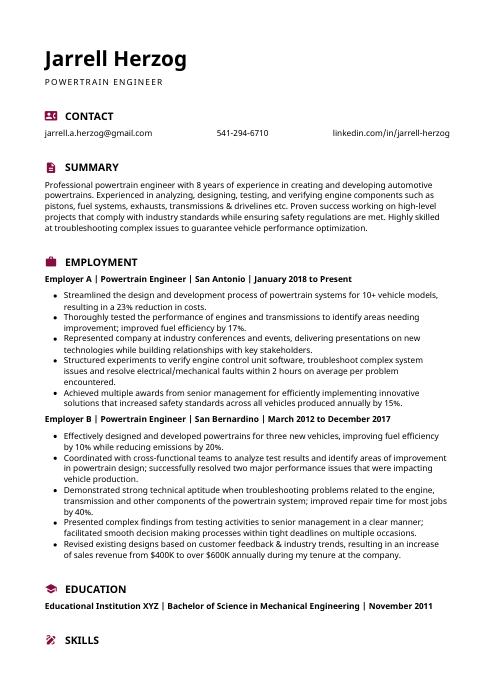 Hoopoe
Hoopoe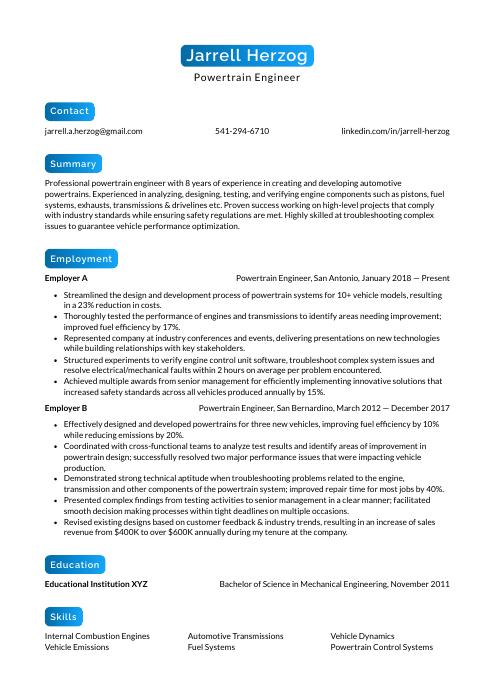 Kinkajou
Kinkajou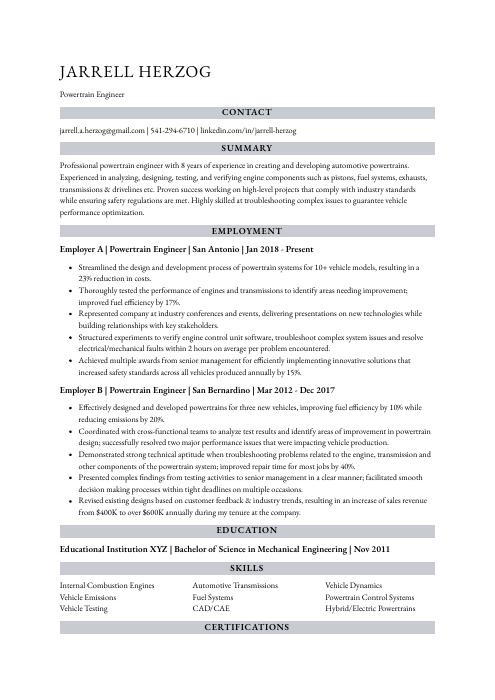 Numbat
Numbat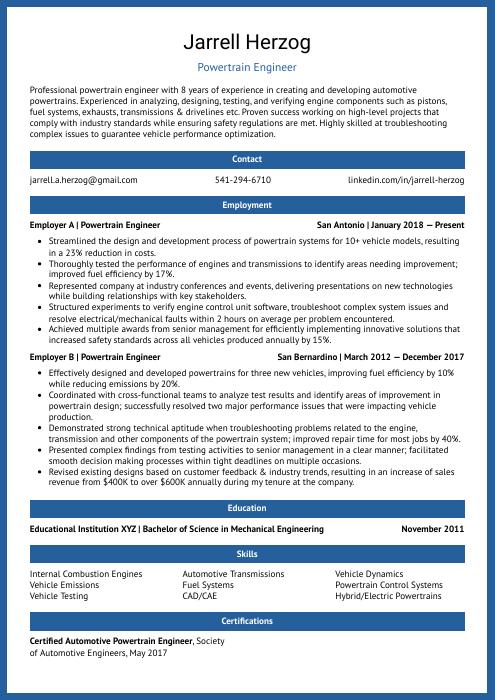 Ocelot
Ocelot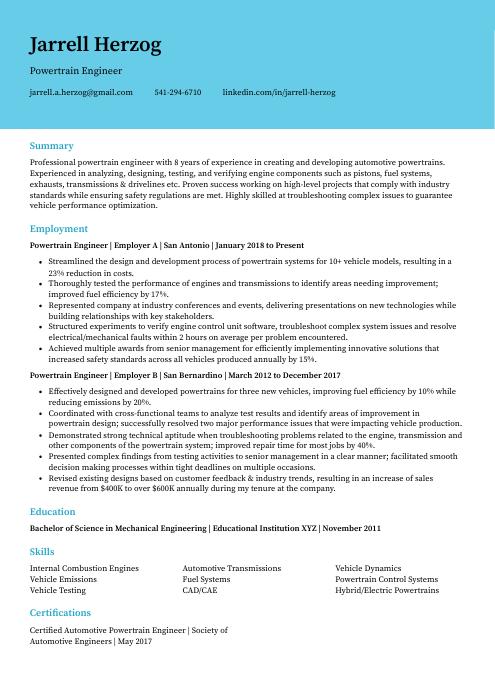 Dugong
Dugong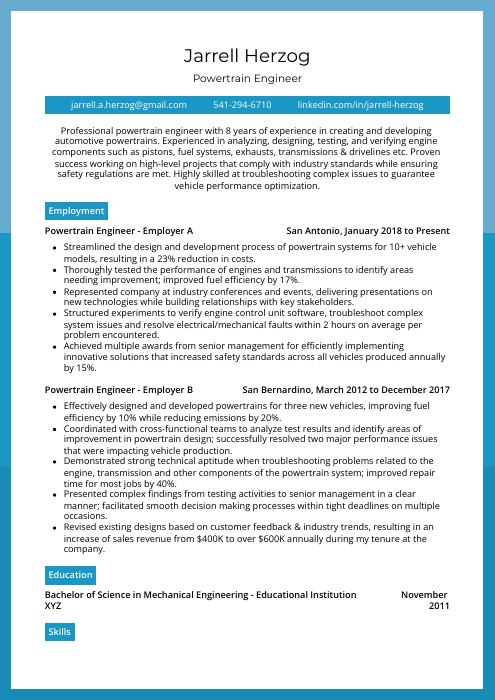 Rhea
Rhea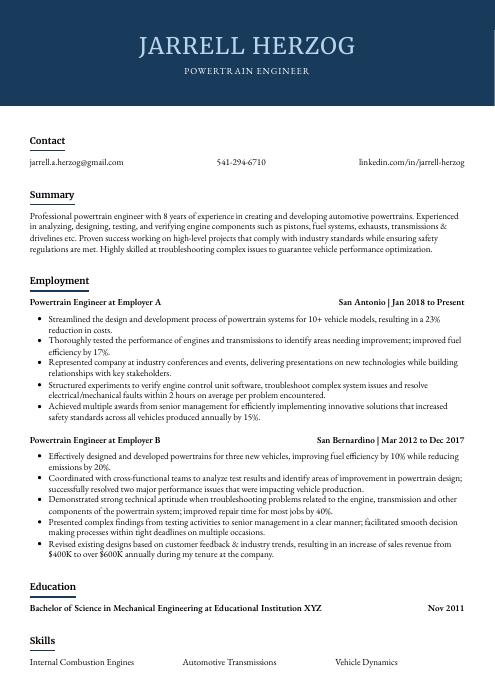 Bonobo
Bonobo Rezjumei
Rezjumei
